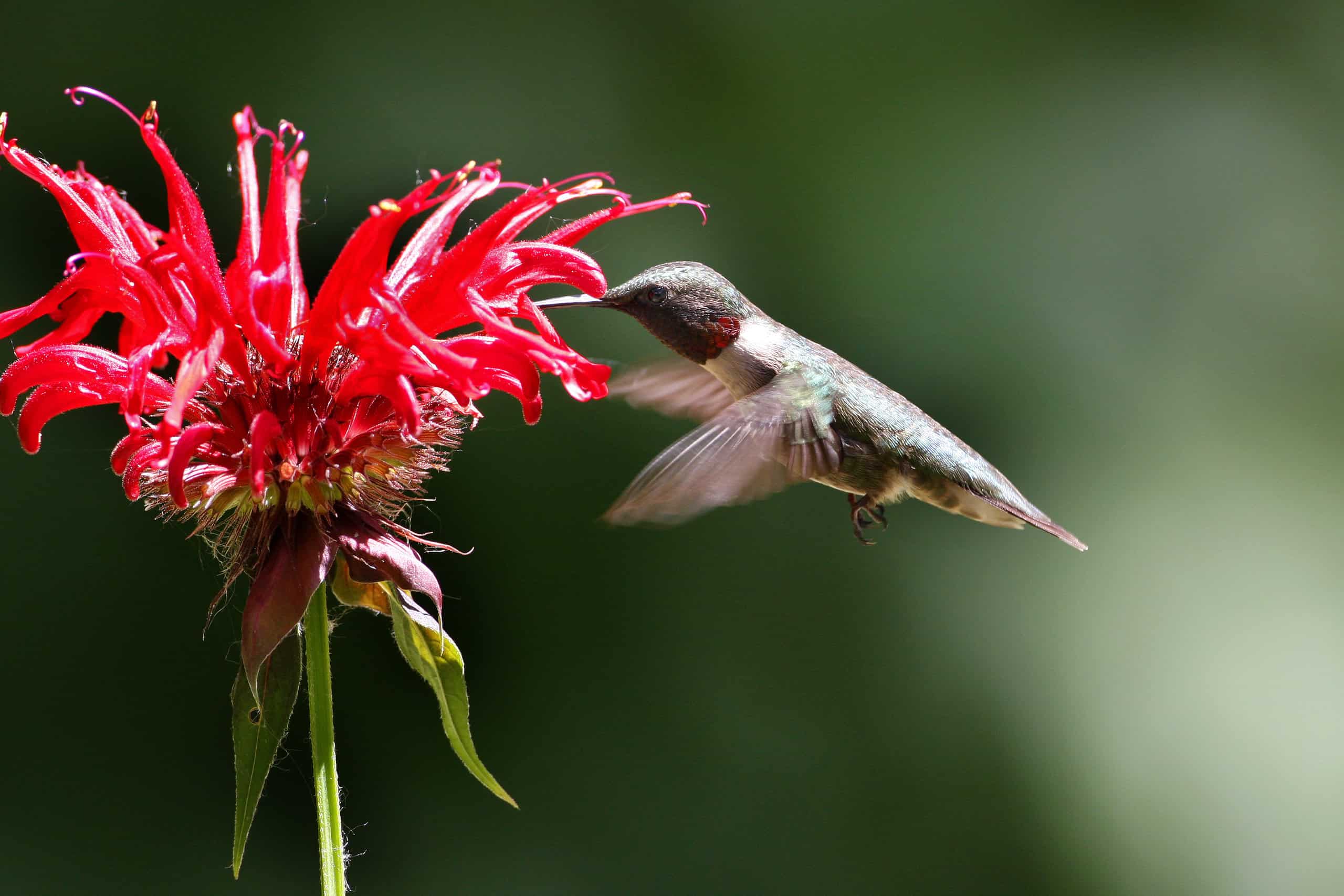
Giant hyssop is among the plants that hummingbirds will visit in your Florida garden.
©Danny Hummel/Shutterstock.com
Florida’s diverse ecosystems provide an ideal environment for hummingbirds, and the state serves as a vital stopover during their annual migration. From coastal regions to subtropical landscapes, Florida offers a rich array of flowering plants and a climate that supports hummingbird populations. By creating a welcoming habitat and providing the right resources, you can attract these captivating creatures to your yard and enjoy their presence throughout most of the year. Keep reading to discover how you can turn your yard into a hummingbird haven that entices these charismatic birds in “Hummingbirds in Florida: 10 Plants They Love and Seasonal Timing.”
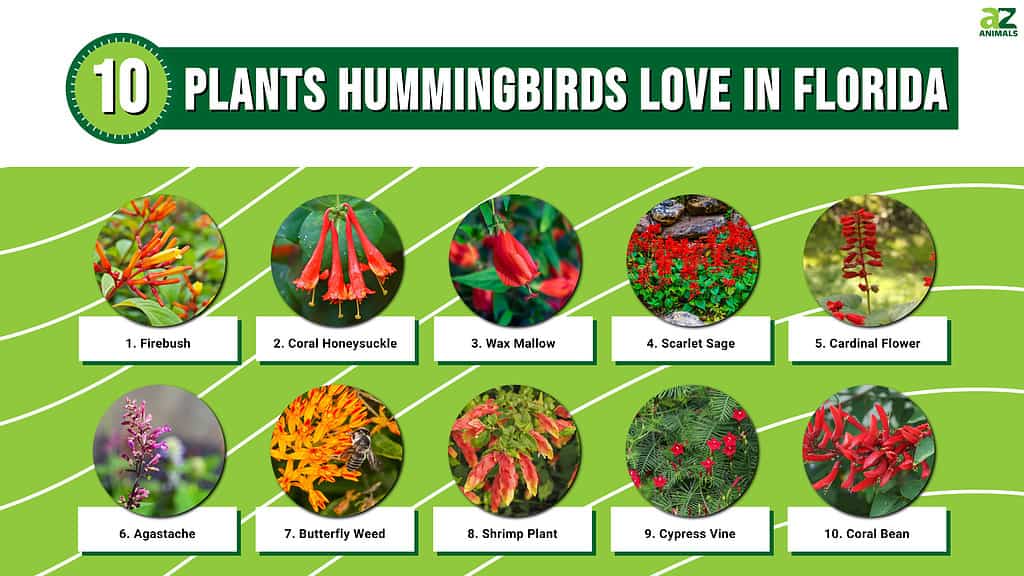
Hummingbirds in Florida: Common Species
Attracting hummingbirds to your yard in Florida can be a rewarding experience. Ruby-throated (Archilochus colubris), black-chinned (Archilochus alexandri), and Rufous (Selasphorus rufus), hummingbirds are the three most common species found in Florida. Providing a variety of nectar-rich plants will appeal to all of them.
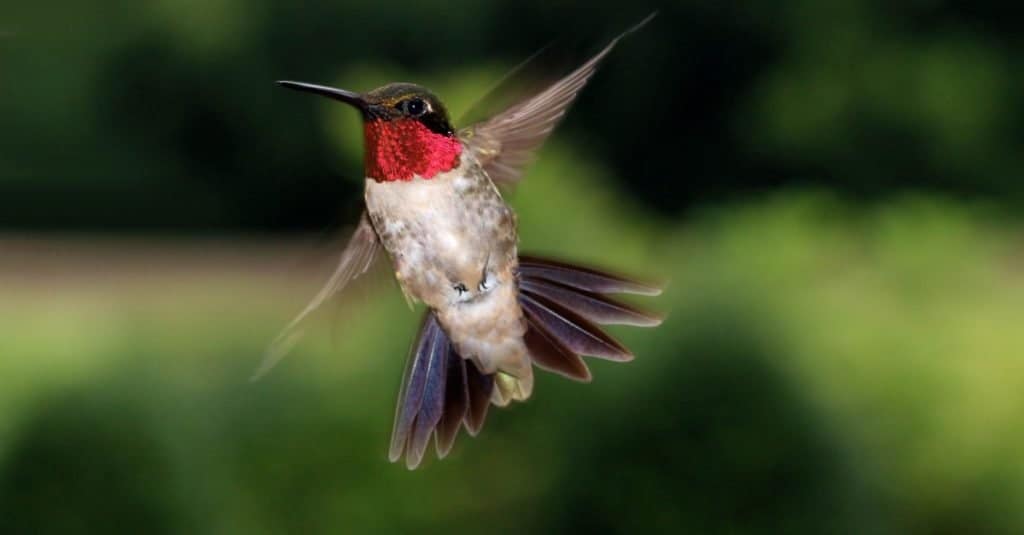
A male
ruby-throated hummingbird
in flight.
©Ramona Edwards/Shutterstock.com
The ruby-throated hummingbird, with its dazzling emerald-green feathers and ruby-red throat, is a delightful visitor that adds life and beauty to any outdoor space. Ruby-throated Hummingbirds call Florida home between March and September, though some live year-round in South Florida. They are attracted to red, tubular flowers. Planting firebush, coral honeysuckle, red salvia, cardinal flower, and bee balm can significantly increase the chances of attracting these mesmerizing green birds to your yard. These plants not only offer a rich source of nectar but also provide the hummingbirds with perching spots and cover.

A female ruby-throated hummingbird feeds the chicks in the nest.
©Agnieszka Bacal/Shutterstock.com
Black-chinned Hummingbirds are infrequent visitors to Florida. They are more widely distributed throughout the Western U.S., primarily passing through Florida during their migration. Planting coral honeysuckle, red salvia, and trumpet creeper in your yard can attract them as they pass through the area, encouraging them to stop by for nourishment.

Black-chinned Hummingbirds are infrequent visitors to Florida. They are more widely distributed throughout the Western U.S.
©rck_953/Shutterstock.com
During the winter months, the rufous hummingbird occasionally visits Florida. Rufous hummers nest further north than any other species of hummingbird. They have been found as far north as Alaska! To attract these wintering hummingbirds, consider planting begonias, while having auxiliary feeders at the ready.

Male Rufous Hummingbirds are brightly colored, with a reddish-orange face.
©Keneva Photography/Shutterstock.com
Hummingbirds in Florida: Seasonal Timing
Hummingbirds are a diverse group of birds primarily found in the Americas, ranging from Alaska to Tierra del Fuego. However, the majority of their species are concentrated in the tropical regions of Central and South America. Of over 300 known species, only a small fraction of hummingbirds call North America home. Hummingbirds are highly specialized creatures that have evolved to thrive in specific environments. They have adapted to the nectar-rich habitats found in tropical rainforests, cloud forests, and other lush ecosystems that provide a consistent food source. These habitats offer an abundance of flowering plants, which supply the nectar that forms the mainstay of their diet.
While some hummingbird species can tolerate temperate climates, harsh winters in many parts of North America limit the survival and breeding success of hummingbirds that are adapted to warmer climates. As previously mentioned, the ruby-throated hummingbird is the only resident hummingbird in Florida, though rufous and Black-chinned hummers pass through during their migration in spring and fall.

The ruby-throated hummingbird is the only
residenthummingbird in Florida.
©John L. Absher/Shutterstock.com
Seasonal Behavior
Hummingbirds are known for their energetic and active behavior. In Florida, their activity patterns vary seasonally. Hummingbirds are present throughout most of the year, but their activity levels can fluctuate depending on the season: During spring, which is the breeding season, hummingbird activity tends to increase. This is when you are most likely to observe courtship displays and males defending their feeding territories. In the summer months, hummingbird activity remains fairly high as they continue breeding and raising their young. During the fall, hummingbird activity may start to decline as some individuals migrate to their wintering grounds. However, some hummingbirds, like the Ruby-throated Hummingbird, may still be present in Florida during this time. Winter months in Florida can still have some hummingbird activity, particularly with the arrival of migratory species such as the Rufous Hummingbird. Winter is a good time to keep feeders available to attract these wintering individuals.
Daily Behavior
Hummingbirds are diurnal creatures, meaning they are most active during daylight hours. Their peak activity tends to occur during the early morning and late afternoon when the sun is low. They search for nectar-rich flowers and feeders. They are known for their rapid wing beats, hovering abilities, and quick flights, allowing them to visit numerous food sources in rapid succession.
Hummingbirds in Florida: 10 Plants They Love
Hummingbirds rely on a diverse range of flowers throughout the year, so it’s beneficial to include a mix of early, mid, and late-blooming plants in your yard. Maintaining clean and well-filled hummingbird feeders can supplement their natural nectar sources and further attract these delightful birds. By creating a hummingbird-friendly habitat with an abundance of nectar-rich plants, you increase the chances of attracting and providing sustenance to these fascinating creatures right in your own backyard.
1. Firebush
Firebush (Hamelia patens) is a native shrub in Florida that produces tubular red-orange flowers. It is highly attractive to hummingbirds and often referred to as a “hummingbird magnet.” It ranges from Florida to Argentina.

Firebush (
Hamelia patens) is a native shrub in Florida that produces tubular red-orange flowers.
©Little daisy/Shutterstock.com
2. Coral Honeysuckle
Coral honeysuckle (Lonicera sempervirens) is a vine with trumpet-shaped red or coral-colored flowers. It blooms throughout the year and is a favorite of hummingbirds due to its abundant nectar.
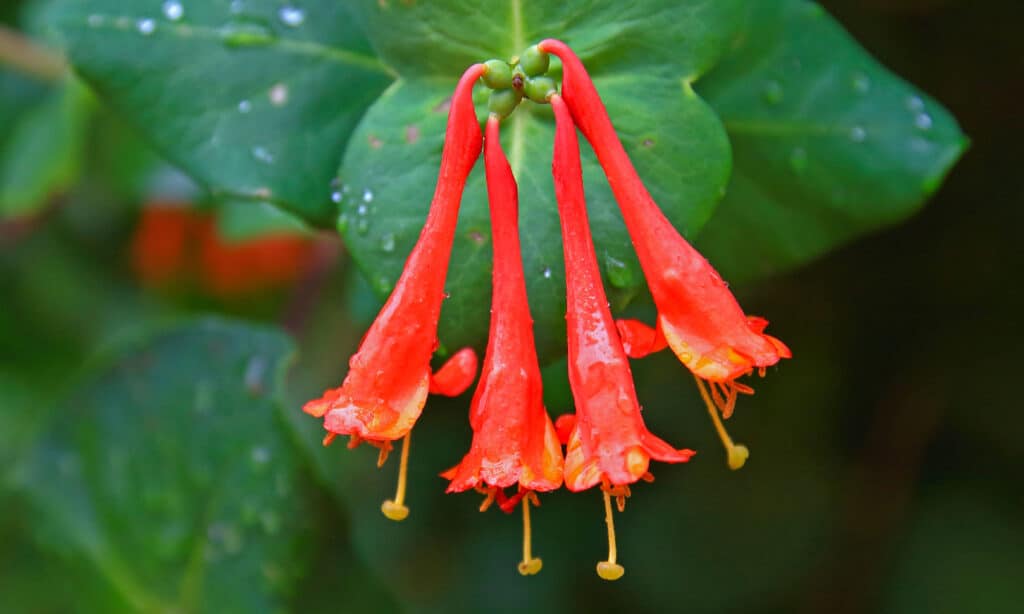
Coral honeysuckle is a hummingbird magnet.
©iStock.com/Vera Tikhonova
3. Wax Mallow
Wax Mallow (Malvaviscus arboreus) is a perennial shrub with red tubular flowers. that curl back, resembling a Turkish turban. For this reason, it is sometimes referred to as Turk’s cap. Its flowers are rich in nectar and attract hummingbirds.

Wax Mallow (
Malvaviscus arboreus)is a perennial shrub with red tubular flowers.
©NOPPHARAT9889/Shutterstock.com
4. Scarlet Sage
Scarlet sage (Salvia splendens) produces vibrant red flowers that are irresistible to hummingbirds. These plants are often cultivated in gardens and landscapes.
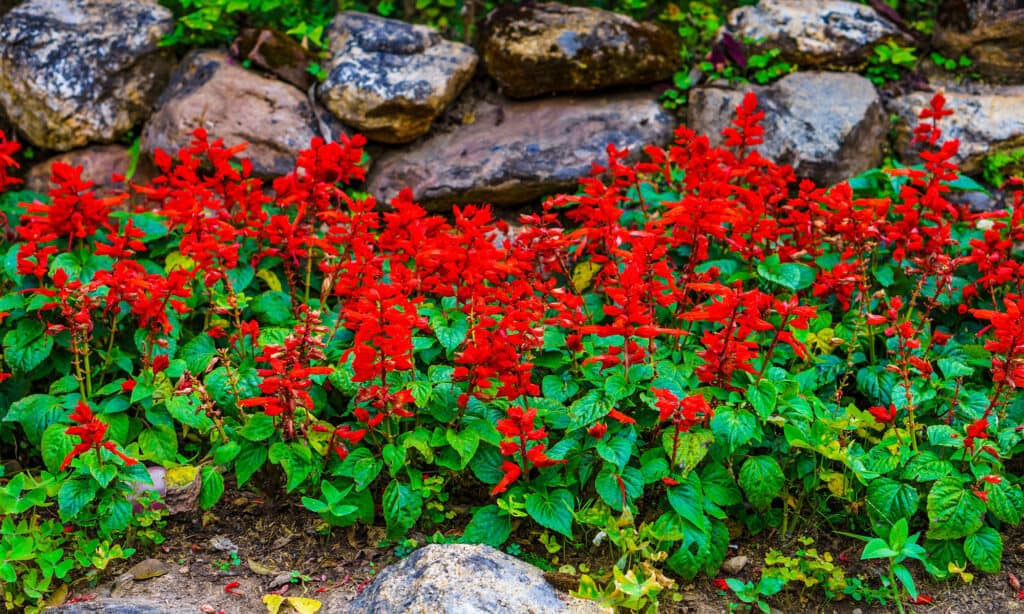
Scarlet sage (
Salvia splendens) produces vibrant red flowers that are irresistible to hummingbirds.
©JoeyPhoto/Shutterstock.com
5. Cardinal Flower
Cardinal flower (Lobelia cardinalis) is a native perennial with bright red, tubular flowers that hummingbirds find particularly attractive. It thrives in moist habitats like marshes and along the edges of ponds or streams.

Cardinal flower (
Lobelia cardinalis) is a native perennial with bright red, tubular flowers that hummingbirds find particularly attractive.
©iStock.com/laroy lindsey
6. Agastache
Various species of Agastache (Agastache) such as mosquito plant or hummingbird mint (Agastache cana) and giant hyssop (Agastache scrophulariifolia), produce spikes of tubular flowers that are tempting to hummingbirds.
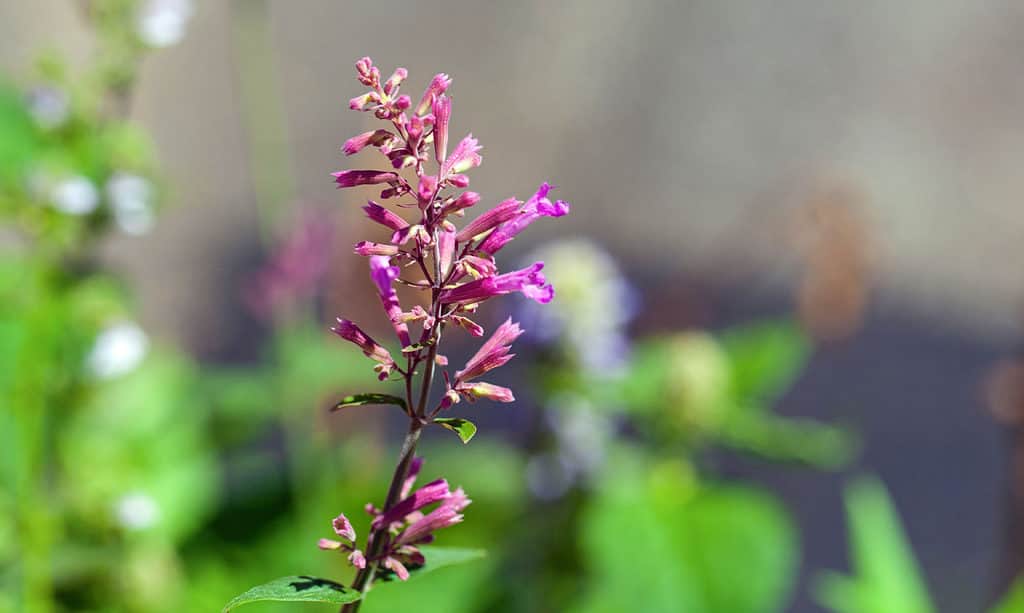
Hummingbird mint is also known as the double bubble mint and mosquito plant.
©ChWeiss/Shutterstock.com
7. Butterfly Weed
Butterfly weed (Asclepias tuberosa): Although primarily known for attracting butterflies, butterfly weed also captures the attention of hummingbirds. Its clusters of bright orange and yellow flowers provide a good source of nectar.

Although primarily known for attracting butterflies, butterfly weed also captures the attention of hummingbirds.
©Elliotte Rusty Harold/Shutterstock.com
8. Shrimp Plant
Shrimp plant (Justicia brandegeeana) is a magnet for hummingbirds. The plant produces vibrant red bracts that resemble shrimp, which are particularly attractive to hummingbirds. The nectar-rich flowers of the shrimp plant serve as a food source. It is a popular choice for gardeners looking to attract these beautiful birds to their yards.

The plant produces vibrant red bracts that resemble shrimp, which are particularly attractive to hummingbirds.
©LifeCollectionPhotography/Shutterstock.com
9. Cypress Vine
Cypress vine (Ipomoea quamoclit) is a flowering vine known for its delicate foliage and vibrant red trumpet-shaped flowers. Native to tropical regions of the Americas, particularly Mexico and Central America, the cypress vine is widely cultivated and appreciated for its ornamental value. Hummingbirds find the flowers of cypress vine alluring. Due to its climbing nature, the cypress vine is often grown on trellises, fences, or other structures.
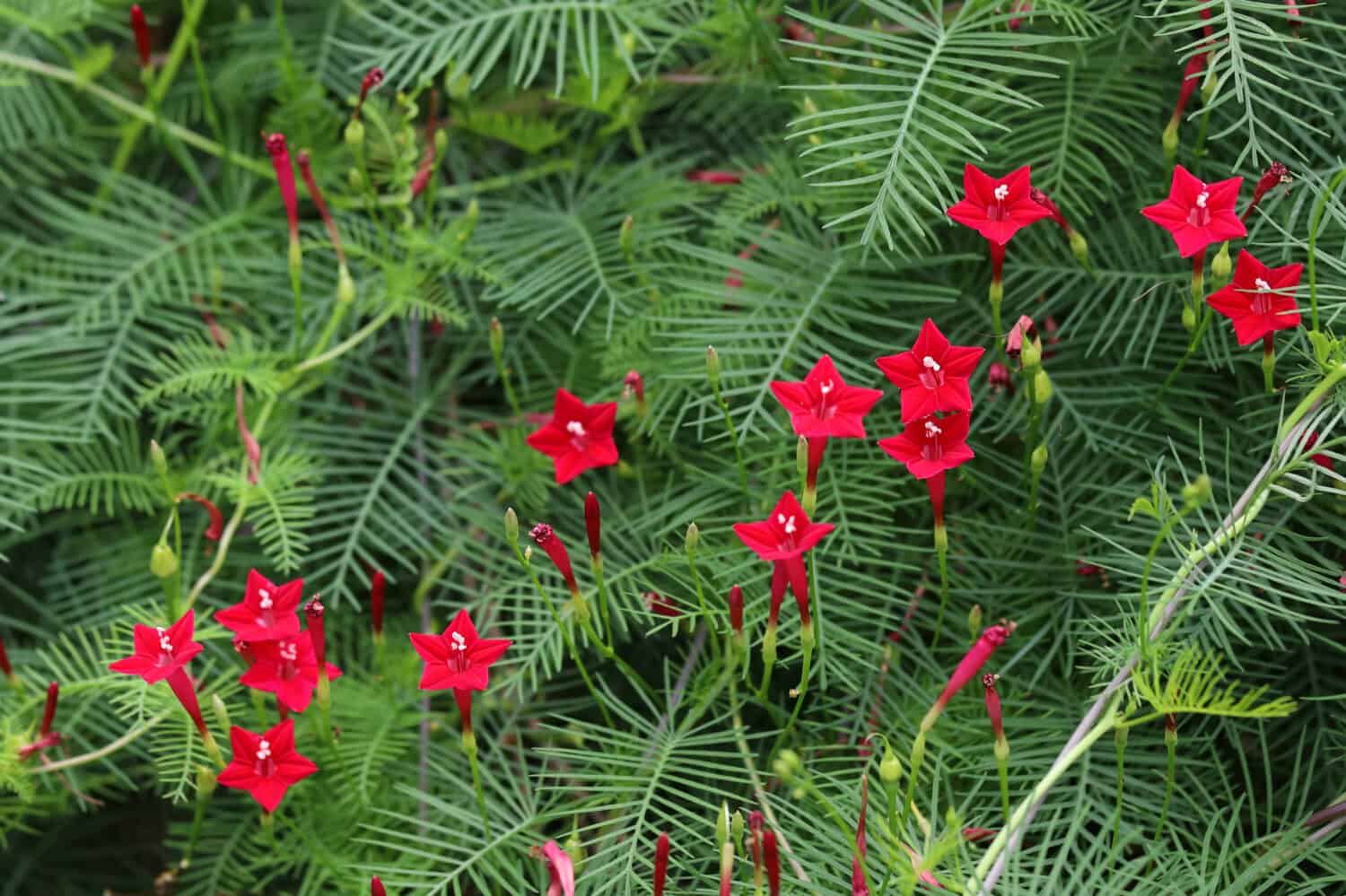
Cypress vine (
Ipomoea quamoclit) is a flowering vine known for its delicate foliage and vibrant red trumpet-shaped flowers.
©Passakorn Umpornmaha/Shutterstock.com
10. Coral Bean
Coral bean (Erythrina herbacea) is known for its striking, showy flowers. The leaves are composed of three leaflets and are medium to dark green in color. The most notable feature of coral bean is its inflorescence, which consists of clusters of tubular, bright red or orange-red flowers. These flowers, which appear in spring or early summer, are pollinated by hummingbirds. After pollination, they develop into long, bean-like seedpods.

Coral bean
(Erythrina herbacea)is known for its striking, showy flowers
©Beach Creatives/Shutterstock.com
Thank you for reading! Have some feedback for us? Contact the AZ Animals editorial team.

